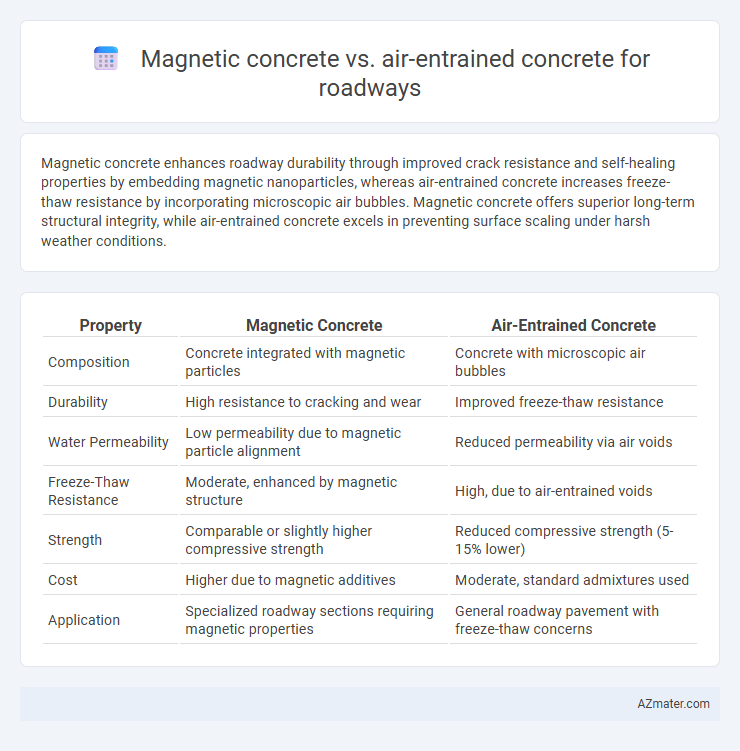Magnetic concrete enhances roadway durability through improved crack resistance and self-healing properties by embedding magnetic nanoparticles, whereas air-entrained concrete increases freeze-thaw resistance by incorporating microscopic air bubbles. Magnetic concrete offers superior long-term structural integrity, while air-entrained concrete excels in preventing surface scaling under harsh weather conditions.
Table of Comparison
| Property | Magnetic Concrete | Air-Entrained Concrete |
|---|---|---|
| Composition | Concrete integrated with magnetic particles | Concrete with microscopic air bubbles |
| Durability | High resistance to cracking and wear | Improved freeze-thaw resistance |
| Water Permeability | Low permeability due to magnetic particle alignment | Reduced permeability via air voids |
| Freeze-Thaw Resistance | Moderate, enhanced by magnetic structure | High, due to air-entrained voids |
| Strength | Comparable or slightly higher compressive strength | Reduced compressive strength (5-15% lower) |
| Cost | Higher due to magnetic additives | Moderate, standard admixtures used |
| Application | Specialized roadway sections requiring magnetic properties | General roadway pavement with freeze-thaw concerns |
Introduction to Magnetic Concrete and Air-Entrained Concrete
Magnetic concrete incorporates ferromagnetic materials, enhancing the concrete's durability and self-sensing capabilities, making it suitable for advanced roadway applications. Air-entrained concrete contains microscopic air bubbles introduced by air-entraining agents, improving freeze-thaw resistance and reducing surface scaling in cold climates. Both technologies address durability but differ in their mechanisms and ideal environmental conditions for roadway construction.
Defining Characteristics of Magnetic Concrete
Magnetic concrete incorporates ferromagnetic materials such as iron filings or steel fibers, enhancing its electromagnetic properties and structural integrity for roadway applications. This type of concrete offers improved crack resistance and self-sensing capabilities compared to air-entrained concrete, which primarily contains microscopic air bubbles to increase freeze-thaw durability. The magnetic properties enable real-time monitoring of stress and deformation within the pavement, making magnetic concrete a technologically advanced choice for infrastructure requiring enhanced durability and maintenance efficiency.
Key Properties of Air-Entrained Concrete
Air-entrained concrete contains microscopic air bubbles that improve freeze-thaw resistance and durability in roadway applications. This key property reduces surface scaling and cracking, enhancing longevity under harsh weather conditions. The controlled air content also improves workability and reduces permeability, making it ideal for pavement exposed to deicing chemicals.
Comparative Strength and Durability
Magnetic concrete exhibits enhanced compressive strength and improved microstructural density compared to air-entrained concrete, making it highly suitable for heavy-duty roadway applications. Air-entrained concrete provides superior freeze-thaw durability due to its controlled microscopic air bubbles, effectively reducing cracking in cold climates. While magnetic concrete excels in overall mechanical performance, air-entrained concrete remains preferred for environments with significant cyclic freezing and thawing stresses.
Performance in Freeze-Thaw Cycles
Magnetic concrete exhibits enhanced durability in freeze-thaw cycles due to its improved microstructure and reduced permeability, which minimizes internal water ingress and subsequent cracking. Air-entrained concrete maintains resilience by incorporating microscopic air bubbles that provide space for ice expansion, significantly improving freeze-thaw resistance and reducing surface scaling. Comparative studies indicate magnetic concrete can outperform traditional air-entrained mixes by offering higher compressive strength retention and lower frost-induced damage in cold climate roadways.
Impact on Roadway Lifespan
Magnetic concrete enhances roadway lifespan by improving crack resistance and self-healing properties through embedded magnetic nanoparticles, reducing maintenance frequency and costs. Air-entrained concrete increases durability by creating microscopic air bubbles that improve freeze-thaw resistance, preventing surface scaling and extending service life in cold climates. Comparing both, magnetic concrete offers advanced structural resilience while air-entrained concrete provides superior protection against environmental stressors, jointly contributing to prolonged roadway durability.
Installation and Maintenance Considerations
Magnetic concrete incorporates ferromagnetic materials enhancing roadway durability but requires specialized equipment for installation and precise material handling to avoid magnetic interference with machinery. Air-entrained concrete improves freeze-thaw resistance by introducing microscopic air bubbles, allowing standard installation techniques but demands careful air content monitoring during mixing for optimal performance. Maintenance for magnetic concrete involves regular inspection of magnetic properties to ensure integrity, whereas air-entrained concrete requires periodic checks for surface scaling and air void stability to maintain durability.
Environmental Impact and Sustainability
Magnetic concrete incorporates magnetic particles that enhance its durability and reduce the need for frequent repairs, leading to lower overall carbon emissions compared to traditional air-entrained concrete. Air-entrained concrete improves freeze-thaw resistance by introducing microscopic air bubbles, which extends pavement life but requires more cement, contributing to higher CO2 emissions. Sustainable roadway design increasingly favors magnetic concrete for its potential to minimize environmental impact through longer service life and reduced maintenance.
Cost Analysis for Roadway Projects
Magnetic concrete incorporates ferrous materials that enhance durability and reduce maintenance costs, potentially offsetting its higher initial price compared to traditional air-entrained concrete. Air-entrained concrete, commonly used for roadways due to its improved freeze-thaw resistance, generally presents lower upfront costs but may lead to increased lifecycle expenses from repair and replacement. Evaluating total cost of ownership in roadway projects shows magnetic concrete offers long-term economic benefits through extended pavement lifespan and reduced rehabilitation frequency.
Future Prospects and Innovations
Magnetic concrete incorporates ferromagnetic materials to enhance structural monitoring and electromagnetic shielding, presenting significant potential for smart roadway infrastructure with real-time condition assessment and improved durability. Air-entrained concrete, designed with microscopic air bubbles, remains crucial for frost resistance and longevity in cold climates, but emerging innovations focus on integrating nanoscale additives to further increase strength and reduce permeability. Future advancements may see a hybrid approach combining magnetic properties and optimized air entrainment, enabling smarter, more resilient roadways capable of withstanding environmental stresses and providing enhanced safety features.

Infographic: Magnetic concrete vs Air-entrained concrete for Roadway
 azmater.com
azmater.com